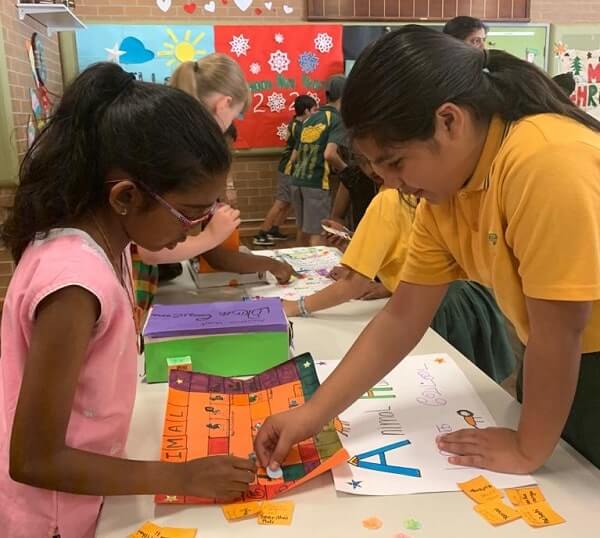Girraween Public School turned a lot more colourful than usual recently as Tamil/Hindi language students turned up in traditional attire for their annual showcase concert. Some 700 primary school students learn an Indian language at the school, 300 in Tamil classes and 400 in Hindi classes, in Years 1 to 4.

At the recent showcase, students performed to popular Tamil and Hindi songs, and presented beautiful recitations of Tamil and Hindi versions of English rhymes such as Wheels On The Bus, Head Shoulders Knees and Toes, and Baby Shark.
“This is the second year of this celebratory event,” Premala Nadesan, a Tamil teacher at the school, told Indian Link. “The kids are excited not only to wear their traditional garments, but also to see their friends and teachers in theirs! It is a great feeling for the children to see the whole school involved in their culture even if for a day.”
Even Principal Glenn Walker participated, joining the language teachers in a dance performance to the current Hindi hit Aankh Maare.

It was a presentation that went down well with students as well as parents in attendance.
About the significance of learning languages, Hindi teacher Kanu Tandon said, “Language classes help to reach out to the third-generation children. If we don’t create the awareness for them about their language now, they may eventually lose it altogether. In our culture-integrated language classes, kids share their experiences from home more than they would out in the playground, and so it all adds up.”

Anjali Dhond, another Hindi teacher, added, “These classes also help in relating better to their extended families back in India especially grandparents.”
Kids attend community language classes for an hour every week during school hours, in which they perform a variety of language tasks. Anjali said, “The kids work on specific reading, listening, writing and speaking tasks designed by us and get to analyse and explore the language. We assess their ability through final tasks in which they perform activities such as a role play and present a piece.”

Fruits names in Hindi 
A student displaying Hindi placard
Tamil teacher Heerthayini Janapalachandran chimed in, “Our teaching techniques are quite different to how we learned languages ourselves as kids. The Tamil/Hindi syllabus that we teach here is modified to cater to the children brought up in Australia. Over and above pen and paper, we make our lessons fun and engaging: we are responsible to instill interest in the kids first and then gradually get them conversing confidently. It actually works, because at the end of Year 4, the kids want to continue their language lessons.”
In preparations for the showcase, the students actively engaged in project-based learning, working in groups to develop puzzles and games.

Creative projects exhibited by students 
s
Archana, a Year 4 student, said, “I think it is important to read and write my own language. I’m enjoying my language classes. I worked on a project about different Tamil festivals. My favourite Tamil festival is Tamil New Year.”
Another student Chitrita said, “I’m originally from Bangladesh. I learn Hindi here. I am thrilled to learn a new language.” For her project, Chitrita created a book of flowers with their names in Hindi. Anokshikhaa learned the names of animals in Tamil for her project.

Talking at the event, Principal Glenn Walker said, “By learning an additional language, students will develop skills in areas of communication, intercultural understanding, social cohesion, language and intercultural awareness. Community language classes are an important link to our community.
Next year we will expand the language classes by including Telugu.”
Heerthayini agreed that language learning results in enhanced cognitive skills. Not only is there better speech and hearing, she shared, but also greater focus, efficient memory, ability to juggle between tasks, manage conflicts, and better information processing overall.
For migrant kids, such programs also help in identity formation, foster self-esteem, and keep at bay feelings of social isolation.
“Our son did not know a word of Tamil before joining this school,” admitted Hema, a parent who attended the showcase. “Now he is increasingly using Tamil at home. We love it that he is able to learn his mother tongue at school.”
Kalyani, another parent said, “We are Telugu speakers but have enrolled our child in the Tamil class. We figured it would be good to learn at least one Indian language. We are thrilled to hear the Principal’s announcement regarding Telugu!”
Read also:Urdu Mahabharata e-book in Rekhta’s virtual library




